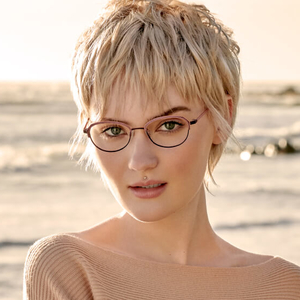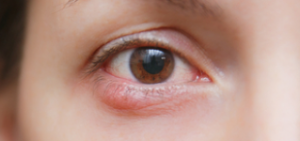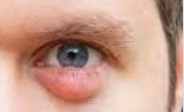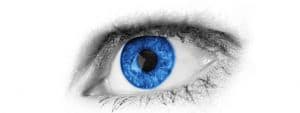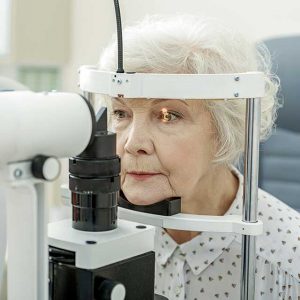If your eyelid is turning in and your eyelashes are rubbing against your eye, you may have entropion.
Up to 2.1 percent of adults over age 60 are diagnosed with entropion. This irritating (literally and figuratively!) eyelid condition can cause significant discomfort as the eyelashes constantly rub against the front of your eye, and can really affect your quality of life.
Wondering if entropion is causing your ocular discomfort? Schedule an eye exam to be sure. Your eye doctor will perform a series of tests to determine if entropion is the source of your symptoms and prescribe an effective treatment plan.
How is entropion diagnosed?
Entropion is diagnosed during a comprehensive eye exam of your eyelids. Your eye doctor will assess your eyelid’s position on the eye, its muscle tone, shape and tightness.
Using a bright light and a device known as a slit lamp, your eyelids will be thoroughly examined under high magnification.
The entropion is diagnosed when an eyelid, most commonly the lower eyelid, is turned in and the skin and eyelashes are rubbing against the ocular surface and cornea.
Examination of the eyelids will include:
- Facial architecture
- Eyelid laxity
- Eyelid pathology
- Corneal assessment
Diagnosis of the cause of the eyelashes facing inward is vital as this could be due to a benign growth or cancer of the eyelids.
Your eye doctor will also examine the tissue surrounding the eye to determine if the entropion is caused by scar tissue, previous eye surgery or another eye condition.
Contact an eye doctor near you if you notice any changes in your eyelids or are experiencing any eye pain or discomfort.
SEE RELATED: What is Entropion?
How is entropion treated?
Entropion is effectively treated using different methods, depending on the underlying cause of the condition.
Entropion caused by inflammation or infection may resolve on its own when the underlying cause is treated. However, the presence of any eyelid scarring may prevent the entropion from healing completely, even after the inflammation or infection has been treated.
To fully correct entropion, surgery is the primary choice of treatment.
Short term treatment methods
The following treatments may be recommended for mild cases of entropion, or at least until a surgical procedure is performed.
- Soft contact lens. Wearing a soft contact lens (with or without an optical prescription) over the affected eye can serve as a protective barrier for the cornea.
- Botox. Injections of Botox into the lower eyelid can turn the eyelid outward and away from the eye’s surface, with the effects lasting up to 6 months.
- Stitches. Placing several stitches along the affected eyelid can temporarily help the eyelid turn outward. After the stitches are removed, resulting scar tissue helps to maintain the outward position— though this typically only lasts for several months.
- Skin tape. Transparent skin tape can be applied to the eyelid to prevent it from turning in.
Surgery for entropion
There are several types of procedures that can correct entropion. Your eye doctor will determine which type of procedure is most appropriate for you, depending on the cause of the entropion and the health of the surrounding tissues.
Entropion caused by aging. This involves the removal of a small part of the lower eyelid in order to tighten the muscles and tendons of the lid. Your surgeon will then suture the outer corner of your eye or under your lower eyelid.
Entropion caused by previous surgery or inner-eyelid scarring. This involves a mucous membrane graft procedure. Skin from the roof of your mouth or from your nasal passages will be removed and grafted onto the lower eyelid to provide the necessary support.
What to expect before and after your procedure
Prior to your procedure, your surgeon will numb your eyelid and surrounding tissue with a local anesthetic. You may also be offered a sedative to help you feel more comfortable and relaxed during the procedure.
Following the surgical procedure, you may be prescribed an antibiotic ointment to use for one week post-surgery, in order to prevent infection.
Applying cold compresses for several days can also help to reduce inflammation and bruising— both of which are a normal occurrence following these types of procedures.
If your eyelid feels tighter than normal, rest assured that this feeling will disappear as your eye heals over the next two weeks. Your eye doctor will likely request that you make an appointment to remove your stitches one week post-surgery.
Home remedies relieve entropion symptoms
The following home remedies can help to relieve some of your symptoms until your surgical procedure:
- Keep your eyes moist. Lubricate your eyes with artificial tears eye drops and ointments to help prevent corneal damage. Moisture shields can be especially helpful when worn overnight.
- Apply skin tape. Skin tape can be used to help your eyelid remain in position and prevent it from turning inward. Your eye doctor can demonstrate how to correctly place the tape near your eyelids.
LEARN MORE: Guide to Dry Eye
If you have noticed any changes in the appearance of your eyelids, schedule an appointment with an eye doctor near you for a proper diagnosis and effective treatment plan.
The sooner entropion is diagnosed and treated, the sooner you will enjoy comfortable eyes and clear vision.

